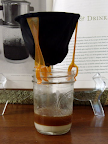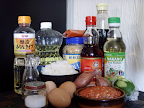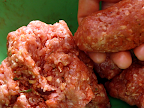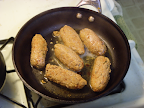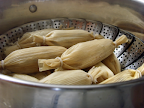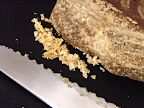Background
We were fortunate to find the very comprehensive Exotic Ethiopian Cooking by D.J. Mesfin, which had an entire section dedicated to breakfast. This book gave us several options, such as genfo, which is a porridge made with barley or wheat flour. Genfo frequently came up when we searched online and is probably the best known breakfast meal. But we decided against making this because we were afraid we would end up with glue if we messed it up.
We chose instead to make qinch'e (kinche), which is a cracked wheat porridge with spiced butter. We had to substitute bulgur wheat for cracked wheat, as we were unable to find it, and one store manager told me that it was no longer available(!). Bulgur wheat is an appropriate substitute, since the only difference between the two is that bulgur wheat is steamed and toasted prior to the cracking. This also makes it cook faster!
The flavor of the qinch'e came from the nit'ir qibe, which is a spiced butter. The recipe in the book is for twelve pounds of butter, and they ask you clarify the butter before you flavor it. We had about four ounces of ghee on hand, so we started with that and scaled down the spices.
- 4 oz of ghee (clarified butter)
- 1 tbsp minced ginger
- 1 small clove of garlic, chopped
- 1 small shallot, chopped
- 1/4 tsp fenugreek seeds
- 1/4 tsp cumin seeds
- 1/4 tsp oregano
- 2 small cardamom pods
- dash of turmeric

- Melt ghee at low heat.
- Add all the remaining ingredients and cook at low heat for 15 minutes, stirring frequently.
- Strain the nit'ir qibe before using or storing.
- 1 cup milk
- 1/2 cup water
- pinch salt
- 1 cup bulgur wheat
- 4 oz nit'ir qibe
- Bring the water, milk, and salt to a boil, stirring to ensure they do not separate.
- Add bulgur wheat and strained nit'ir qibe; continue to stir frequently.
- The butter will separate and be on the surface at the beginning. As the wheat cooks the butter will suddenly be absorbed.
- Once the butter has been absorbed continue to cook the qinch'e until it reaches the desired consistency.
Ethiopian-Style Coffee
- 1 cup coffee beans (the original recipe asks you to roast your own)
- 1/4 cinnamon stick
- 1/4 tsp cloves
- 28 oz water
- Grind the coffee and spices to a fine powder.
- Bring the water to a boil, add the coffee, and continue to boil for five minutes.
- Strain coffee, and serve in small cups (such as Chinese teacups or demitasse cups).
This breakfast was very successful. The most complicated part was making the nit'ir qibe, which could easily be made in large quantities beforehand. It should be noted that making good nit'ir qibe is vital to this dish since it is most of the flavor. In our case it was a nice subtle flavor that was a little cheesy and buttery.




